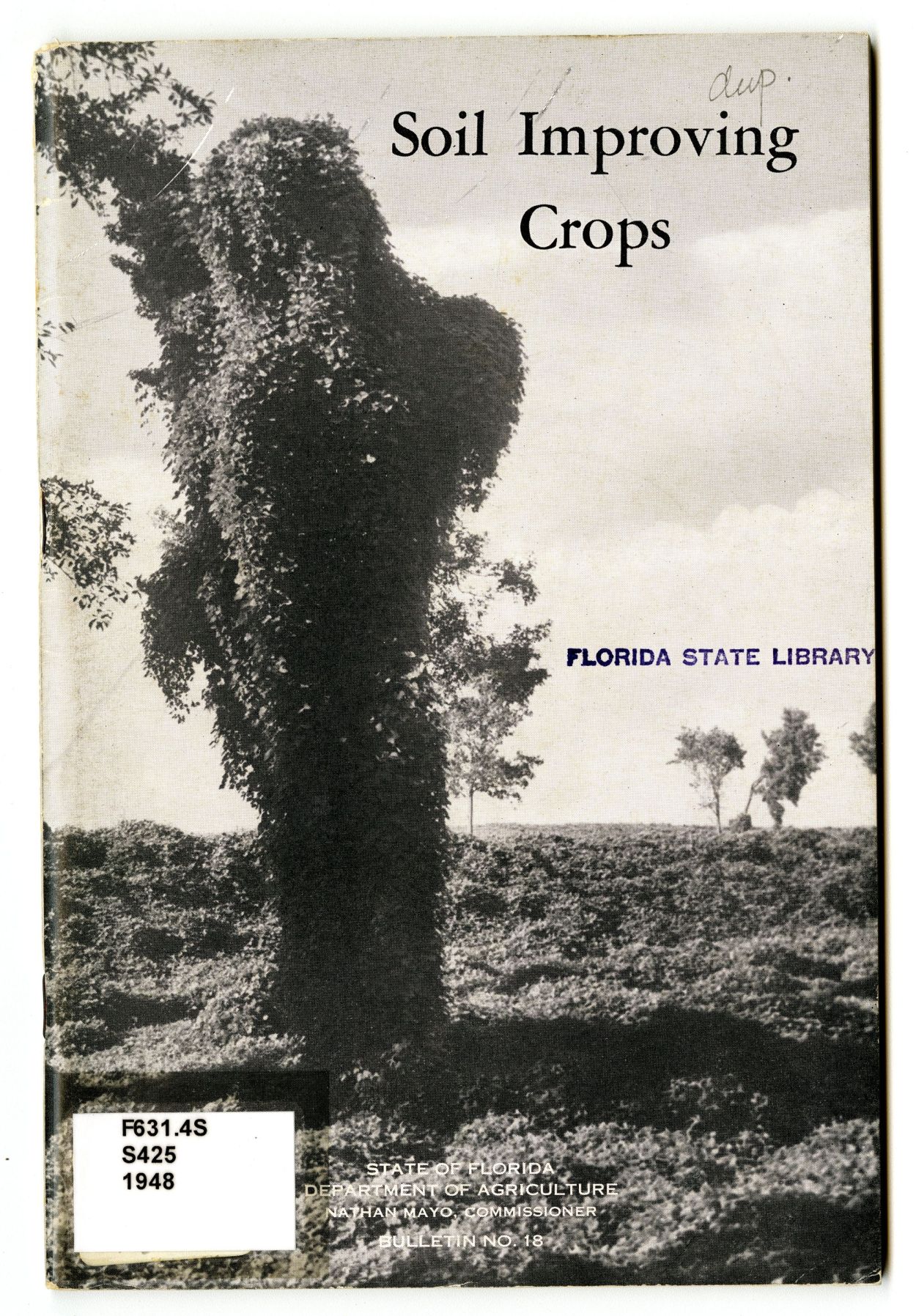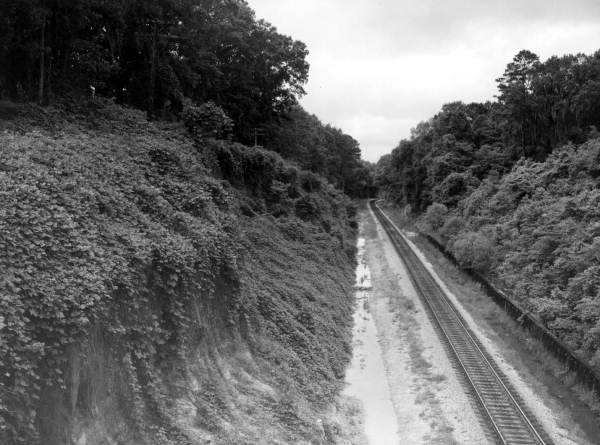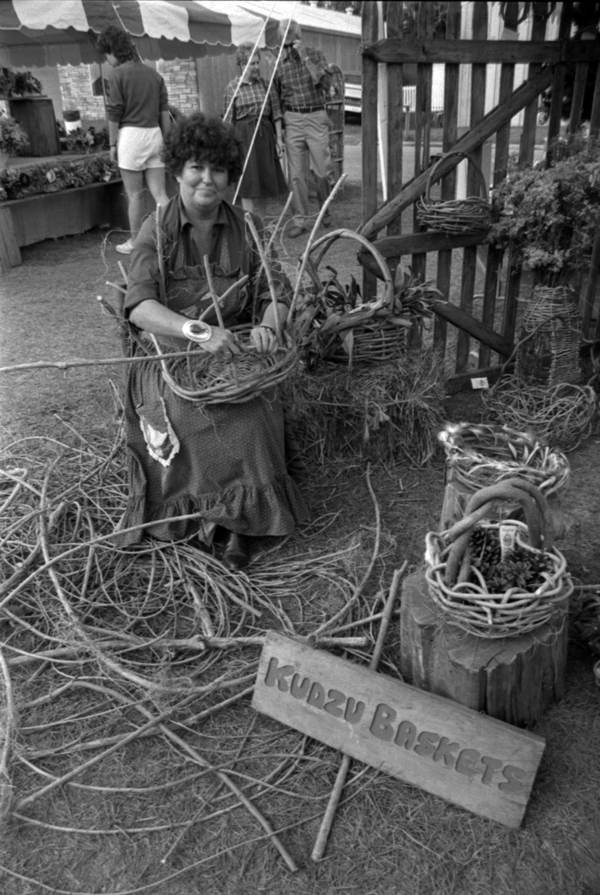Description of previous item
Description of next item
The Vine That Ate the South
Published July 7, 2018 by Florida Memory
If you’ve spent much time driving around North and Central Florida, chances are good that you’ve seen vines take over a few trees and power poles. It happens. Plenty of vines like Virginia creeper and wild grapevine love Florida’s climate and are all too happy to climb up a tree or pole to get a little closer to the sun. One vine in particular, however, has developed a reputation for being almost evil in its quest to grow and thrive, choking out anything that stands in its way. Kudzu (Pueraria thunbergiana) has in recent decades been drubbed as “the green menace” and “the vine that ate the South,” with tendrils that allegedly grow so fast they can outwalk a human. While we doubt kudzu really has nefarious intentions, it certainly is an invasive plant, and it has a history almost as complex as its bewildering carpet of vines and leaves.
Kudzu is native to Asia, where both Japanese and Chinese farmers have used it for centuries as food for livestock and ground cover to prevent erosion. It most likely first came to the United States in 1876, when representatives of the Japanese empire brought along a few cuttings to show off in their exhibit at the Centennial International Exposition in Philadelphia. The vines were hardy and the leaves were attractive, so visitors were delighted to take home a few plants for ornamental use. Southerners appreciated kudzu’s potential as an erosion control agent, and soon it was sprouting in valleys and gullies all over the Carolinas, Georgia, Alabama, and Mississippi.
While kudzu may have possibly entered Florida before 1900, it really burst onto the scene just after the turn of the 20th century, thanks to the diligent boosterism of a Chipley photographer and planter named Charles Earl Pleas. An Indiana native, Pleas and his wife, Lillie, had grown kudzu near their home to serve as a shade vine. When the plant began to creep out onto the lawn–as kudzu tends to do–Pleas dug it up and threw it onto a trash heap near the barn. Determined to survive, the vines took root and began to cover the trash pile and the nearby building.
Then, something unexpected happened. Pleas noticed that all kinds of farm animals, from hogs to horses, seem to enjoy eating the vine. He wrote the U.S. Department of Agriculture to find out if kudzu was known to be poisonous, and the agency responded that it was not, although they also doubted livestock would eat the plant. Seeing that kudzu’s potential as forage had not yet been realized, Pleas and his wife launched a veritable kudzu crusade, promoting the vine as a miracle solution to the South’s long-standing need for a cheap, hardy yearlong food crop for livestock.
Pleas wrote glowingly about kudzu for newspapers and pamphlets, praising its high nutritional value and the ease with which it could be cultivated. It could grow up to a foot a day in early summer, for a total of up to 60 feet of new growth in a single growing season. Soon others in Florida, including State Chemist Rufus E. Rose, were promoting kudzu as both a superior feed crop and an instant solution to erosion. And if the vine overgrew its welcome? “It is an easy matter to get rid of Kudzu if desired,” wrote Edward B. Eppes of Tallahassee in 1913. New plants only sprouted from the crowns, he pointed out, so mowing down the crowns with a plow during the heat of summer would be enough to kill the plant dead. “For this reason,” he wrote, “there is no danger of Kudzu ever becoming a pest.”

Cover of a pamphlet titled “Soil Improving Crops,” distributed by the Florida Department of Agriculture in 1948. The image features a field and tree overtaken by kudzu which, in the context of soil conservation, actually had some positive aspects. The State Library’s State Documents Collection contains many books and pamphlets on soil conservation efforts throughout the 20th century.
For a while, Eppes’ evaluation was spot-on. Floridians and their neighbors throughout the South used kudzu as feed and as ground cover to hold the soil in place on hillsides and in gullies. The U.S. Soil Conservation Service began officially recommending it to farmers in 1935, and the Civilian Conservation Corps planted innumerable cuttings along public roadways and railroad embankments. As late as 1944, the federal government paid farmers to cultivate kudzu, hoping it would both preserve the soil and make money for struggling American farmers still reeling from the effects of the Great Depression.
By the 1960s, however, the vine’s reputation had taken a dive. The Pensacola News Journal noted that it had a new nickname– the “cuss you” vine–because it had turned out to have some unfortunate qualities. Yes, kudzu was a good cover crop, but turn your back for just a moment and it might overtake another planted field, and even the barn beyond it! If conditions were right, it could even choke out young pine trees, destroying valuable sources of lumber and pulpwood. The vine snaked its way into everything, taking over unoccupied dwellings, gardens and even utility poles, occasionally shorting out electrical lines. In 1970, the U.S. Department of Agriculture, which had earlier been one of kudzu’s biggest cheerleaders, declared it a common weed and began experimenting with means for eradicating it.
Local and state officials in Florida did what they could to stem kudzu’s green tidal wave as well. Santa Rosa County passed an ordinance in 1996 imposing fines on property owners who allowed kudzu vines to creep onto their neighbors’ land. Hillsborough County opted to use herbicides to beat back the vines. Tallahassee’s Parks and Recreation Department contracted with a sheep farmer to bring hundreds of lambs down to Florida to chow down on the woody growth.
Kudzu still covers millions of acres of territory in the southeastern United States, but is now under somewhat better control. Some people have even used the vine for basket weaving, confections and kudzu cigarettes! Most Floridians, however, prefer to keep the so-called “green menace” as far away as possible.
What are some of the most unusual plants in your Florida community? Let us know by leaving us a comment, and don’t forget to share this post with your friends and relatives!
Cite This Article
Chicago Manual of Style
(17th Edition)Florida Memory. "The Vine That Ate the South." Floridiana, 2018. https://www.floridamemory.com/items/show/334333.
MLA
(9th Edition)Florida Memory. "The Vine That Ate the South." Floridiana, 2018, https://www.floridamemory.com/items/show/334333. Accessed December 5, 2025.
APA
(7th Edition)Florida Memory. (2018, July 7). The Vine That Ate the South. Floridiana. Retrieved from https://www.floridamemory.com/items/show/334333

 Listen: The Assorted Selections Program
Listen: The Assorted Selections Program


